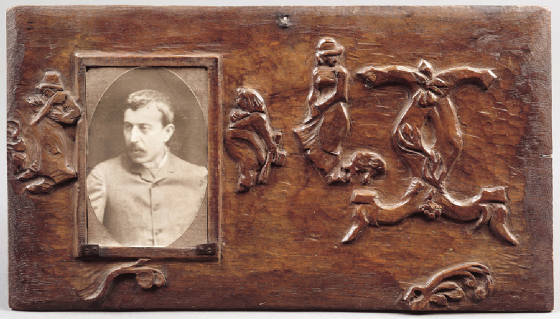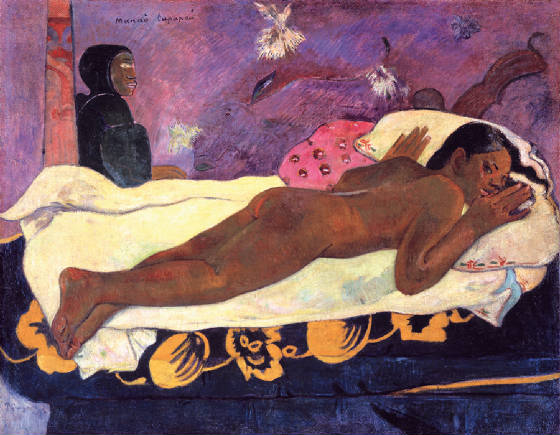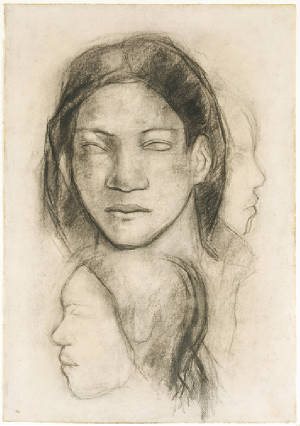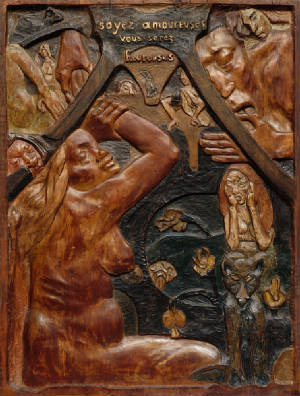
|

|

Paul Gauguin, Embellished Frame of Frame with Two Interlaced "G's", 1881-1883. Carved walnut containing photograph of the artist. Musée d'Orsay, Paris, Gift of
Mme Corinne Peterson in memory of Frederick Peterson and Lucy Peterson.
Gauguin: Maker of Myth
Tate Modern, London, 30 September, 2010 - 16 January, 2011
by Anna Leung
It is appropriate that an exhibition which has as its stated aim to
demythologise Gauguin and yet present him as a maker of myths should begin with
a series of self-portraits in which the artist assumes different personae.
Starting with the Sunday painter equipped with his mandatory bohemian fez it
ends with a disconcerting image of Gauguin, invalided and bespectacled, shortly
before his death in 1903 from syphilitic heart failure while in self-imposed
exile in the Marquesas Islands. He was, one is tempted to say, the
self-sacrificial victim of his own ambitions, for he could have chosen to
return to France for treatment and survive a few more years. It was a risky
wager and he won, for by 1906 he was being posthumously honoured with a major
exhibition at the Salon d’Automne. He knew that for the myth of the ground
breaking anarchic and visionary artist to become a reality he had to forfeit
the comfort of family, friends and, from a more opportunist point of view, Paris.
As Daniel de Montfreid, the friend, to whom was entrusted the business of
selling his canvases in Paris, reminded him, he was ‘that
extraordinary,
legendary artist who sends from the depths of Oceania his disconcerting,
inimitable works, the definitive works of a great man who has disappeared, as
it were, off the face of the earth.’
To retain this status Gauguin made his own
life an integral part of his narrative strategy and in so doing set a precedent
for many modern and postmodern artists whose lives as celebrities risk
cannibalising their lives as artists. Myth suggests something
inexplicable and impenetrable but contrary to these connotations there is much
cause and effect in Gauguin’s life. Gauguin was a late developer. From the age
of 17 he spent several years traversing the globe as a merchant seaman and then
improbably was transformed into a bourgeois gentleman and family man working at
the Bourse as a ‘coulissier’ (an accountant or bookkeeper rather than a stock
broker) where he was in a good position to speculate on stocks and commodities
and provide his Danish wife, Mette, with the luxuries she craved. It was during
this period that he became a Sunday painter and began to collect Impressionist
paintings including canvases by Cezanne - he came to own six - and Pissarro.
But in 1882 he lost his job due to an international financial crash, and it
must have seemed logical to him to abandon his financial career and attempt to
pursue an artistic one. He was already aware that the Impressionists had challenged
the dominance of the Salon, describing their independent exhibition as a ‘battle
against a fearsome power made up of Officialdom, the Press and Money.’ Gauguin was astute enough to
recognise in painting a commodity that could gain in value and to appreciate
the increasing importance of the critic’s role of validating innovation in a
market no longer automatically certified by the prestige of the Salon. Despite
his frequent diatribes against critics and literary men poking their noses into
the visual arts he fully realised the importance of marshalling fashionable
young critics such as Felix Feneon, Albert Aurier
who framed the first
definition of Symbolist art as the subjective expression of an idea in terms of
form, and Octave Mirabeau, who enlisted Mallarme's help when Gauguin was trying
to drum up the necessary funds to return to Tahiti. This resulted in a
Symbolist Banquet where Gauguin was acclaimed as the new leader of the
Symbolist school of painting, an accolade indeed for an ambitious young artist
who knew in more senses than one where he was going and the price he would have
to pay. These were career moves conducted in the
artificial light of publicity motivated by an acute awareness of the market
that was never far from Gauguin’s thoughts, even when in Tahiti’s earthly
paradise. Offstage, the figure holding together all these life-changing
events was
the Franco-Spanish businessman Gustave Arosa, who had become Gauguin’s guardian
when he befriended Gauguin’s mother, Aline, who had been forced by
circumstances to take up a trade as a seamstress. It was through Arosa that
Gauguin obtained his position at the Bourse, through him that he was introduced
to his future wife, Mette Gad, and through him that he met Camille Pissarro,
who tutored Gauguin and handed down his then advanced views on painting. Since
Gustave Arosa was a collector of advanced art, Gauguin would have been exposed from
his teens to avant-garde painting, initially the Barbizon School, but later
paintings by Pissarro and other independent minded artists. In this way his
eyes had already been tutored to Impressionism’s plein air vision with its
informal rendering of contemporary life and its transmission of the faster pace
of urban society through asymmetrical compositions, figures spied from awkward
angles, its vibrant colour field and its emphasis on the materiality of the
medium that revealed the process through which the painting had come into
being. He had no need to shake off the shackles of academic conventions, no
need to relearn a new pictorial syntax that jettisoned chiaroscuro and dramatic
gesture. To this extent he was not a late developer but already ahead of the
game.

Paul Gauguin, Manao tupapau (L'Esprit vielle/The Spirit of the Dead Keeps Watch), 1892. Albright-Knox Art Gallery, Buffalo, A. Conger Goodyear Collection, 1965.
Moving
away from Impressionism
By the beginning of the 1880’s Gauguin was beginning to be recognised as
part of ‘la nouvelle peinture’ as the Impressionists were first known. Though
still a Sunday painter working at the Bourse, from 1879 to 1886 he contributed
to the annual Impressionists’ Independent exhibitions, first with a sculpture
of his wife, Mette, but later, as he came under the tutelage of Pissarro, with
portraits, still-lifes, and landscapes featuring the loose brush work
characteristic of the Impressionist style. His eventual turning away from Impressionism’s emphasis on
optical realism and its insistence of the particularity of things (Zola’s
corner of nature) caused the breakup of his friendship with Pissarro, who never
quite forgave him for his defection from the humanistic and progressive values
of the Impressionists for what he deemed to be no more than decorative
primitivism. Gauguin came to regard Impressionism as an error that only he and
Cezanne stood out against. Neither was content to capture the mundane
contingencies of everyday life and both scorned a literary or literal account
of experience. But whereas Cezanne was intent on capturing the ever shifting
interstices that make up our perception of reality within a shimmering tapestry
of brush strokes and was essentially a classic painter, Gauguin cast a far
wider net and began to see himself as a ‘savage’ able to sense unseen primal
forces and to move beyond the limits of the real. This is what really
interested him, the liminality and interconnectedness of dream and reality, and
he accorded equal if not more importance to the realm of the imagination and to
the way it reconstructs what we construe as reality than to the actuality of
our daily lives. This is already
evident in the two portraits of his children, Aline in The Little One is
Dreaming (1881)]
and Clovis (Clovis Asleep, 1884) whose
schematic dream journeyings we seem to see projected against the walls of their
bedrooms. For Gauguin, art was not about what you can see with the external
eye; it was not about visual data, but was essentially cerebral, philosophical
and poetic.
This may all sound abstruse but Gauguin was well aware of the need for a
new pictorial language to clothe these ideas and his motifs were drawn from a
wide variety of sources, Japanese prints, childrens’ book illustrations,
especially by English illustrators, and the images d’Epinal, the peasant broad
sheets that had already inspired Courbet, all visual material denied access to
the realm of the Fine Arts. But it would be mistaken to think that Gauguin had
turned his back on Western art. It
was always with him, for wherever he went he carried a portable library of
photographs and drawings which he described in a letter to Redon as ‘a whole
little world of comrades that bring me pleasure.’ These includedm], among others, reproductions
of the Parthenon horsemen, Delacroix’s Women of Algiers, Manet’s
Olympia, Puvis de Chavannes’s L’Esperance as well as the Buddhist reliefs
from Borabadur in Java, a nude by Cranach and a series of pornographic photos
from Port Said. Photography gave him access to a world of images, which meant
he could immerse himself in the confluence of art’s histories. Originality may
have been the leitmotif of the avant-garde artist, but many borrowed, some
would say plundered, from past masters. Though down the ages artists have
succumbed to various influences, photography ushered in a new phenomenon, which
we tend mistakenly to associate with postmodernism, by which the study of nature becomes subordinate to that of
culture in terms of pictorial material previously not readily available to past
artists This reusing of already
existing figures, gestures and poses constitutes part and parcel of Gauguin’s
primitivism; his fusing of elements coming from different pictorial sources
which then take on an independent emotional and sensual register can be
paralleled with his fusing of syncretic elements from different belief systems
and religions to recreate what was lost of an indigenous Tahitian culture. This
vision spoke of a renewal, outside of old Europe, that was internationalist and
globalist in tone and which marks him as unusual in his empathetic attitude to
non-western culture but which also provided him the maverick status he sought
as an avant-garde artist.
It is therefore not Gauguin’s subject matter that placed him apart from
the Impressionists but a synthesist interplay between image and idea, or vision
and visionary, that allied him to the Symbolists. Symbolism depends on the
creation of a sense of mystery, and works through suggestion rather than
through literal or direct representation. It permits the artist to journey
inwards into a dream world but in Gauguin’s case and that of many other
artists, such as Ensor and Munch, they did so to highlight the pain and
alienation felt by the artist excluded by society. This feeling of ostracism is
conveyed in his picture Bonjour M. Gauguin (1889), inspired by Courbet,
in which the
solitary artist is seen as a kind of refugee forever fated to eke out an
existence on the margins of society. When faced with his outsider status
Gauguin may have brought to mind Gustave Arosa’s collection of Peruvian
pottery, reawakening memories of his own childhood spent in Lima whose culture
was therefore a part of his own, and perhaps Gustave’s brother Achilles Antoine
Arosa’s mementoes, water colours and sketches, of a voyage taken to Tahiti and
the Marquesas Islands in 1844. The lure of the tropics would have been more
than compelling

Paul Gauguin, Tahitian Faces, c. 1899. Charcoal on paper. The Metropolitan Museum of Art, New York, Purchase, The Annenberg Foundation Gift, 1996.
Fuire
La Bas
The
cultivation of the exotic and of the occult was not new in French
artistic and philosophical circles. It was an important vein of French
nineteenth century Romantic literature that figures in the poetry of Gerard de
Nerval and Baudelaire. Both were seekers of solace in some oriental idyll which
took them to a frontier between reality and dream, their poetry opening doors
to invisible worlds. Nerval actually travelled to the Levant, Baudelaire only
as far as the horizons of his own imaginings. Like Gauguin, who followed in
their footsteps, they were fascinated by the religious concepts of non-western
peoples as a spiritual treasure that had been lost. Implicit too in their
writings was the idea of the accursed poet, ‘le poete maudit’, a
forerunner of Gauguin’s
pro-active ‘savage’ at odds with contemporary urban society with its
instrumental values and its positivistic faith in technological progress. Modern philosophical ideas about
primitivism go back even further to Rousseau and Diderot who contrasted the
freedom of savage men living in harmony within a state of nature with the
concupiscence and depravity of the sophisticated European. Diderot was the
first to fasten on to the sexual freedom of the Tahitians, contrasting it with
the prurience and depravity of their European counterparts whose sexual mores
were based on double standards. Such insights were proffered as a means of
creating a better society based on primitive virtues, but did not advocate a
literal return to a state of nature.
Equally important
artistically, especially in view of Gauguin’s subsequent experiments in
ceramics and wood carving, were his visits to two ethnographical museums in
Paris that specialised in non-Western artefacts, masks and figures as well as
highly decorated everyday objects. Then in 1889 there was the vast
International Fair where Gauguin was entranced by the Javanese village and
began to toy with the idea of emigrating to Vietnam, Cambodia or the recently
annexed Tahiti. But the most accessible source for Gauguin’s exotic imaginings
was a popular novel, The Marriage of Loti by Julien Viaud, the pseudonym
of an ex-
merchant seaman, Pierre Loti, which had been recommended by an enthusiastic van
Gogh. It’s from this time that escape from Europe became an idée fixe in
Gauguin’s mind, though the actual shift from a practice based in Paris to one
premised on some exotic otherness probably predated this and originally took
effect during his stay in Martinique in 1887. The novel described in diary form
the romance between a fourteen year-old Tahitian girl and Loti, a British
midshipman, which was doomed to failure because of insurmountable racial
differences, the dangers of miscegenation to children being especially high on
the list. Gauguin may have started
out with racist opinions close to those of Loti but his ten year stay in Tahiti
changed them and in the end he came to believe in communality and cultural
kinship conjoining all races. Consequently, though it was not till his exile to
the Marquesas Islands that he made friends with his native neighbours, he stood
his ground against a tide of openly racist publications that had as their
objective to provide an ideological support for imperialism and
colonialization. Bringing French civilisation to the colonies was not Gauguin’s
aim. On the contrary he described his own geographical displacement as a
desperate flight from civilisation in order to ‘cultivate’ his own ‘primitiveness
and savagery.’
Placing himself under the aegis of Rousseau, Gauguin undertook a quest that was
both a search for origins and an inner journey where reality and dream became
fused. But in actual fact Gauguin’s residence in the tropics was dependent on
the good offices of the French bureaucracy and its monthly postal service.
Not that he was alone in this search. By the end of the nineteenth
century the cult of going away was fairly widespread. It was certainly not
restricted to France. All over Europe artistic communities or colonies were
springing up, made possible by the opening out of the railways and motivated to
a large part by the need for an economically feasible way of life. Equally
important was the idealised image of the rustic peasant as yet uncorrupted by
the sophistication and gross materialism of urban society. Long before Gauguin
discovered Brittany as an area that had escaped the modifications of modernity
and therefore retained a hold on its age old archaic beliefs it was already a
popular centre for artists and tourists alike. But Gauguin was no topographical
artist and what he was attempting to depict was an inner vision that revealed
the determining role of the imagination in perception. In a letter to van Gogh
he described his ground breaking painting The Vision after the Sermon (1888)
as ‘a struggle (that) only exists in the
imagination of the people praying.’ Animals, too, often stood for external signifiers
of inner mental
states the most noticeable being the fox, possibly an alter ego, in The Loss
of Virginity 1890-91
and again in his 1889 self mocking wood relief Soyez amoureuses, vous serez
heureuses (Be in love and you shall be happy). This carving completely breaks
with the conventional unities of renaissance perspective and represents such a
complete breach with conventional assumptions based on good taste that it seems
to have as its expressive goal the creation of something ugly and in this way
to insist on the artist’s own barbarity, a move which was to become a typical
avant-gardist stratagem.
Twice Gauguin attempted to create an artists’ commune, once in Brittany
and then with van Gogh in Arles; neither met with success. He told a journalist
that his Christ in the Garden of Olives (1889) refers to this ‘crushing
of an ideal
and a pain that is both divine and human.’ His extraordinary Self
Portrait, Vase in
the Form of a Severed Head which may allude to van Gogh’s severing of his
own ear lobe, made in
the same year, carries a similar message. It functions as a self-portrait as
victim and saviour. It is this ambiguity, this plurality of experience that
mingled myth with reality that would in future provide Gauguin with his subject
matter whether in Brittany or in Tahiti, and for which primitivism would
provide an artistic template.
Primitivism
Gauguin’s primitivism was forged in Brittany not in Tahiti. His retreat
to Brittany was forced upon him partly by his failure to fend for his family.
After a number of years constantly beset with worries about money and
unsuccessful attempts to provide for Mette and the five children (who had
returned to Copenhagen in 1884) by taking jobs as unlikely as a tarpaulin
representative and a billposter, in 1886 Gauguin travelled to Pont Avon. This was
a picturesque village already frequented by artists and tourists. Moreover
several academic artists had made their names in the Salon by depicting the
Breton peasantry as representative of an archaic past steeped in an esoteric
religiosity so what Gauguin and his acolytes chose to highlight was not new.
What was new was the pictorial language they made use of, its absence of
perspective and of tonal modelling, i.e. its musical, decorative and
anti-naturalistic aspects that looked back to earlier so called ‘primitive’ art
forms: to Cimabue, for instance, as against the illusionistic accuracy of the
High Renaissance masters.
It was here, working alongside such younger artists such as Emile
Bernard, who later disputed Gauguin’s right to spearhead the new Synthesist
movement, that he began to distance himself from the Impressionists by
insisting on the artist’s right to simplify and distort reality in order to
create an expressive image, colour especially functioning as an imaginative
equivalent of nature rather than a literal likeness. What Gauguin represented
inhabits an ambiguous space that belongs neither to the historical nor the contemporary,
but to an in-between reality situated beyond objective or empirical knowledge.
However, though remote from political issues and seemingly at variance with a
secular and materialist society, his Synthesist vision was acknowledged by the
critic Albert Aurier as betokening a new social order and, therefore, avant-garde
by definition. Gauguin’s paintings were interpreted by contemporary critics as
politically progressive and, therefore, cutting edge despite his
neo-traditional treatment of colour and form and the regressive and escapist
tendencies that led him to resurrect a nostalgic dream of a fast-disappearing
society. This was an analysis that mirrored the ambiguities of Gauguin’s own
character, which leaned towards the aristocrat as well as towards the savage.

Paul Gauguin, Soyez amoureuses vous serez heureuses (Be in Love and You will be Happy),1889. Carved and painted linden wood. Museum of Fine Arts, Boston, Arthur
Tracy Cabot Fund.
|

|

|


